Esgueira is an urban civil parish in the municipality (concelho) of Aveiro, in continental Portugal. The population in 2011 was 13,431, in an area of 17.15 km2 (6.62 sq mi).

Braga is a city and a municipality, capital of the northwestern Portuguese district of Braga and of the historical and cultural Minho Province. Braga Municipality had a resident population of 193,333 inhabitants, representing the seventh largest municipality in Portugal by population. Its area is 183.40 km2. Its agglomerated urban area extends to the Cávado River and is the third most populated urban area in Portugal, behind Lisbon and Porto Metropolitan Areas.

The Municipal Stadium of Braga is an all-seater football stadium located in Braga, Portugal, and the current home of Sporting Clube de Braga. It has a capacity of 30,286 spectators, making it the seventh largest football stadium in Portugal. The stadium was designed by Portuguese architect Eduardo Souto de Moura who was awarded the Pritzker Architecture Prize in part for this design.
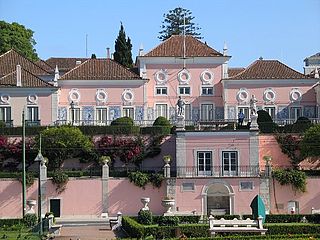
The Belém Palace, formally the National Palace of Belém,, is the current official residence of the president of the Portuguese Republic, the head of state of Portugal. Located in the Belém District of Lisbon, the palace's main façade fronts the Praça Afonso de Albuquerque, facing the Tagus River. A former residence of the Portuguese royal family, the Belém Palace complex is made up of various buildings, wings, courtyards, and gardens, built variously from the 18th to 21st centuries.

Angra do Heroísmo, or simply Angra, is a city and municipality on Terceira Island, Portugal, and one of the three capital cities of the Azores. Founded in 1478, Angra was historically the most important city in the Azores, as seat of the Bishop of the Azores, government entities, and having previously served as the capital city of Portugal during the Liberal Wars. The population in 2011 was 35,402, in an area of 239.00 km2. It was classified as a World Heritage site by UNESCO in 1983.

Povoação is a municipality located in the southeastern corner of the island of São Miguel in the Portuguese archipelago of the Azores. The population in 2011 was 6,327, in an area of 106.41 km2.

Lousã is a town and municipality in the district of Coimbra, in the central part of Portugal. The population in 2011 was 17,604, in an area of 138.40 km2.

Rosenborg Castle Gardens is the oldest and most visited park in central Copenhagen, Denmark. Established in the early 17th century as the private gardens of King Christian IV's Rosenborg Castle, the park also contains several other historical buildings, including Rosenborg Barracks, home to the Royal Guards, as well as a high number of statues and monuments. The park also holds art exhibitions and other events such as concerts in the summer.

Porto Covo is one of the two civil parishes in the municipality of Sines, located along the western Alentejo coast of Portugal, about 170 km (110 mi) south of Lisbon. The population in 2011 was 1,038, in an area of 50.72 km2. Known for its beaches and ties to the ocean, the name Porto Covo likely translates as port of the covos, the term covo referring to a fishing net, used for capturing lobsters and crabs.
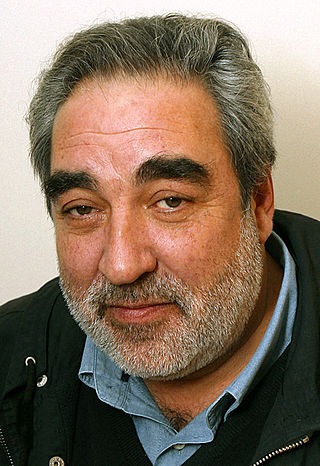
Eduardo Elísio Machado Souto de Moura, better known as Eduardo Souto de Moura, is a Portuguese architect who was the recipient of the Pritzker Architecture Prize in 2011 and the Wolf Prize in Arts in 2013. Along with Fernando Távora and Álvaro Siza, he is one of the alumni of the Porto School of Architecture, where he was appointed a Professor.

The Tidal Mill of Corroios is a 15th-century pluvial mill situated in the civil parish of Corroios, municipality of Seixal.

The Palace of Raio is a Baroque era residence in the urbanized area of the municipality of Braga, in the civil parish of São José de São Lázaro. It is an example of the late Baroque, early Rococo style of decoration by Portuguese architect André Soares, notable for his influence in the northern Baroque movement.

The Coliseum of Porto is a Portuguese theatre and concert venue in the municipality of Porto, in northern Portugal, with a capacity for a standing audience of 4000. A leading venue for music and cultural events in Porto, together with Batalha Cinema, the Coliseu is an example of Portuguese Streamline Moderne and Art Deco styles in the city of Porto.

The Praça do Império is a city square and park situated adjacent to principal monuments and tourist attractions in the civil parish of Belém, municipality and Portuguese capital of Lisbon.

The Palace of Freixo is a former-residence in the civil parish of Campanhã, in the northern Portuguese city of Porto.
The Ducal Palace of Vila Viçosa is a royal palace in Portugal, located in the civil parish of Nossa Senhora da Conceição, in the municipality of Vila Viçosa, in the Alentejo, situated about 150 km east of the capital Lisbon. It was for many centuries the seat of the House of Braganza, one of the most important noble houses in Portugal. Braganza was the ruling house of the Kingdom of Portugal from 1640 until 1910, when King Manuel II, titular head of the family, was deposed in the 5 October 1910 Revolution which brought in a Republican government.
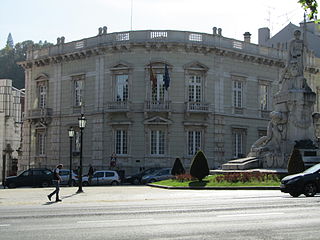
The Palacete Mayer is a Portuguese eclectical residence situated in the civil parish of Santo António, municipality of Lisbon. In the 20th century, it was acquired by the Spanish government and became the Embassy of Spain in Portugal.
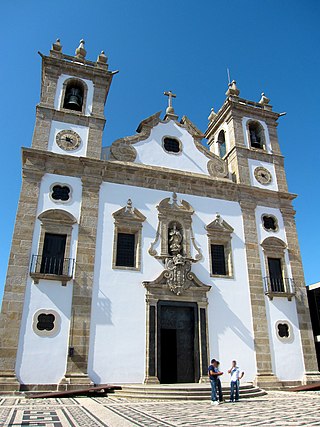
The architecture of Póvoa de Varzim, in Portugal, demonstrates a broad variety of architectural styles over its thousand years of history. 11th-century Romanesque, 16th-century Mannerism, 18th-century Baroque, late 18th-century neoclassicism, early 20th-century Portuguese modernism and late 20th- to early 21st-century contemporary architectural styles and more are all represented in Póvoa de Varzim. As a whole it represents a rich eclectic tradition and innovation shaped by the people, their beliefs and economy.
The Palace and Gardens of Panaca, sometimes characterized as the Palácio Palha is a palace within the Santa Engrácia area of the civil parish of São Vicente, in the municipality in the Portuguese capital of Lisbon.
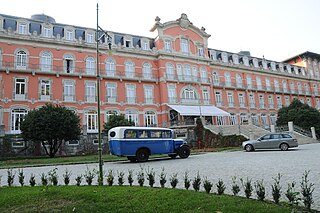
The Hotel Palace of Vidago, is a hotel located in the civil parish of Vidago, Arcossó, Selhariz e Vilarinho das Paranheiras, in the municipality of Chaves, Portuguese district of Vila Real.

















